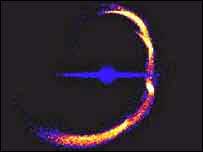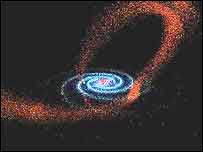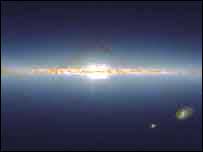 |
Home |
File a UFO Report |
View UFO Reports |
|
![]()
'Alien' stars invade Milky Way
SOURCE: BBC Science News
By Dr David WhitehouseBBC News Online science editor
Torn apart and devoured
Thousands of stars stripped from a nearby dwarf galaxy are streaming through our own Milky Way, according to astronomers.
The break-up has scattered stars. These "alien" stars could at times be close to our Sun, they say.
The interlopers were spotted on a new survey of the entire sky.
This allowed them to remove obscuring foreground objects and get a good look at what lies around our Milky Way.
The break-up has scattered stars
Using data from the Two-Micron All Sky Survey (2Mass) - a study of the sky in infrared light - astronomers are showing that our Milky Way is devouring one of its neighbours.
The analysis is the first to map the full extent of the nearby Sagittarius galaxy, showing how this galaxy, which is 10,000 times smaller in mass than our own, is being stretched out - torn apart and devoured by our Milky Way.
"It's clear who's the bully in the interaction," says Steven Majewski, professor of astronomy at the University of Virginia, US.
"If people had infrared-sensitive eyes, the entrails of Sagittarius would be a prominent fixture sweeping across our sky."
The cosmic violence cannot be seen easily because of the stars, gas and dust that are in the way.
To get a better view, astronomers used the 2Mass infrared maps and digitally removed millions of foreground stars to leave a type of star called an M giant.
The new image shows that stars and star clusters now in the outer parts of our Milky Way have been ripped from Sagittarius by our Milky Way's gravity.
These large, infrared-bright stars act as tracers because they are populous in the Sagittarius galaxy but uncommon in the outer Milky Way.
"We sifted several thousand interesting stars from a catalogue of half a billion," says professor Michael Skrutskie, also of the University of Virginia. "By tuning our maps of the sky to the right kind of star, the Sagittarius system jumped into view."
Processed to show the Milky Way's outskirts
The end of Sagittarius
"We are seeing Sagittarius at the very end of its life as an intact system."
"Astronomers used to view galaxy formation as an event that happened in the distant past," says David Spergel, a professor of astrophysics at Princeton University, US, after viewing the new findings.
"These observations reinforce the idea that galaxy formation is not an event, but an ongoing process."
And Martin Weinberg of the University of Massachusetts, US, says: "After slow, continuous gnawing by the Milky Way, Sagittarius has been whittled down to the point that it cannot hold itself together much longer.

Sagittarius has been smeared across space
Majewski and his colleagues have been surprised by the Earth's proximity to a portion of the Sagittarius debris.
"For only a few percent of its 240-million-year orbit around the Milky Way galaxy does our Solar System pass through the path of Sagittarius debris," Majewski says.
"Remarkably, stars from Sagittarius are now raining down on to our present position in the Milky Way.
"Stars from an alien galaxy are relatively near us. We have to re-think our assumptions about the Milky Way galaxy to account for this contamination."

